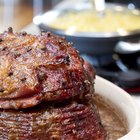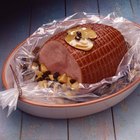bhofack2/iStock/GettyImages
How you choose to prepare a ham has as much to do with the type of ham as your personal preferences. Dry-cured Italian prosciutto and Spanish jamon are usually thin-sliced and served without cooking, while country-style American hams must be soaked or simmered before they're baked. Most hams sold in the U.S. are pre-cooked, which simplifies matters. They must only be reheated to a safe temperature, a simple thing to do if you have a thermometer.
Basic Food Safe Temperature
If you're buying a pre-cooked ham in the original packaging, just as it came from the processing plant, your task is simple and straightforward. The ham reached a food safe temperature while it was cooked by the processor, and went immediately into sterile packaging. That means you only need to reheat it until it reaches a temperature above the food safety danger zone, or 140 degrees Fahrenheit. Test it by inserting an instant-read thermometer into the thickest part of the meat, taking care that it's in the actual meat and not touching the bone or a pocket of fat.
Heating a Repackaged Ham
The situation changes if the ham was taken out of its original packaging and cut down into smaller portions. The original processing plant packs its hams under tight supervision from the U.S. Department of Agriculture, but that's not the case with a local butcher shop and other retailers. During the cutting process, it's quite possible for the ham to become contaminated by bacteria on the meat saw, knives or cutting surfaces at the retail outlet. To compensate for the added risk, these hams should be reheated to 165 F. That's hot enough to kill most of the bacteria and parasites that cause foodborne illnesses.
Do It Again
Ham is just as good, and sometimes better, on the second day. For any frugal cook, that's one of its most ingratiating characteristics. Whether you're heating your leftover ham in one piece for slicing, or whether you've incorporated it into a pasta dish or casserole, the same rules apply. Heat the leftovers to a temperature of 165 F to kill any bacteria it has accumulated since it was first cooked. Be especially careful if you're reheating your ham in the microwave, which heats unevenly. Turn it regularly, and let the ham rest for a few minutes so the temperature can equalize throughout the dish. Test it in several places with your instant-read thermometer, if you're uncertain.
Do the Other Things Right
Of course, heating your ham to the correct temperature is just part of the picture. To ensure food safety, it's important to do a few other things right. Keep the ham cold while you bring it home from the store, ideally in a picnic cooler with ice or a frozen gel pack. The ham should never spend more than two hours outside of refrigeration before it's cooked. After it's cooked, cool it to room temperature as quickly as possible and get it into the refrigerator within two hours. It'll cool more quickly if you slice the ham or cut it into smaller pieces.
Related Articles

Cooking Instructions for a Ridge Creek ...
How to Make Spiral Ham in Crock-Pot

How to Store Uncooked Smoked Ham

How to Keep Ham Slices Warm for ...

How to Bake a Smithfield Spiral Ham

Is it Bad to Cook a Frozen Ham?
Can You Freeze a Spiral Ham?

How Do I Roast a Picnic Ham?

How to Reheat a Ham

How to Heat Pre-Cooked Hams

How to Cook a Daisy Ham

How to Julienne Ham
Crock-Pot Ham and Bean Soup Recipe

How to Cook a Boneless Ham on a ...
The Difference Between a Spiral-Cut Ham ...
How Long Do You Smoke Ham Per Pound?

How to Cook Country Ham in an Electric ...

How to Remove the Mold From Country Ham

How Long After Buying a Beef Roast Is ...

How to Fully Cook a Hickory Smoked Ham
References
Writer Bio
Fred Decker is a trained chef and prolific freelance writer. In previous careers, he sold insurance and mutual funds, and was a longtime retailer. He was educated at Memorial University of Newfoundland and the Northern Alberta Institute of Technology. His articles have appeared on numerous home and garden sites including GoneOutdoors, TheNest and eHow.